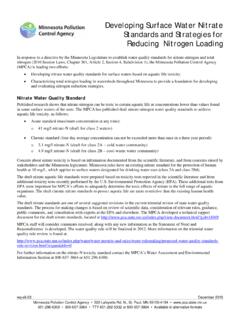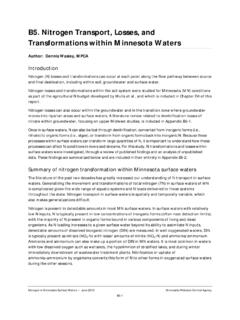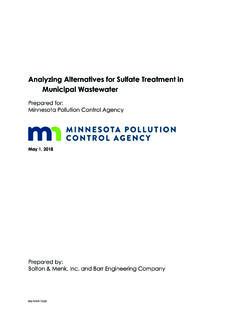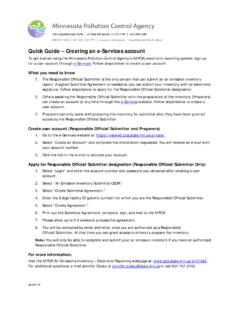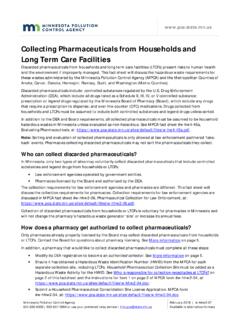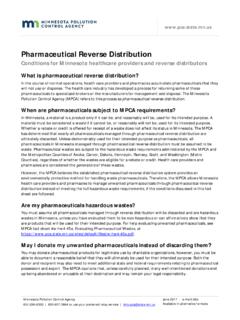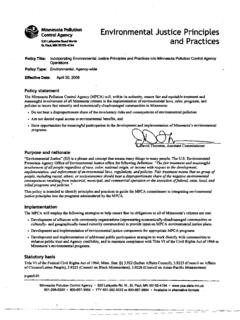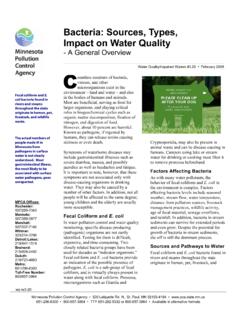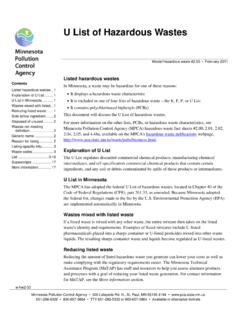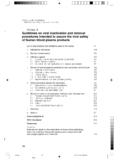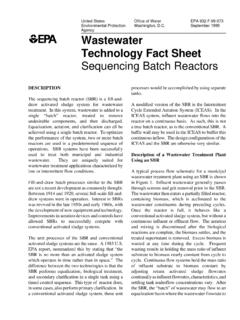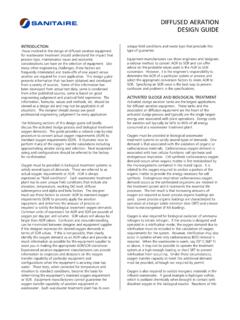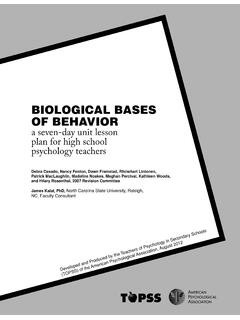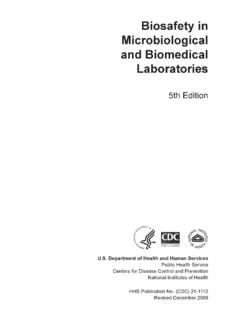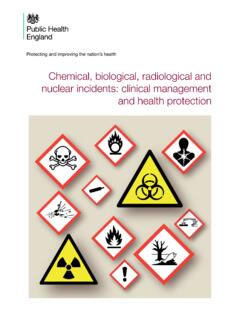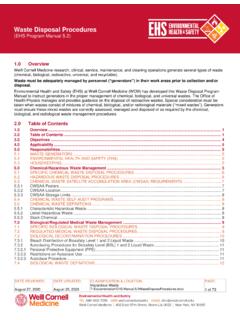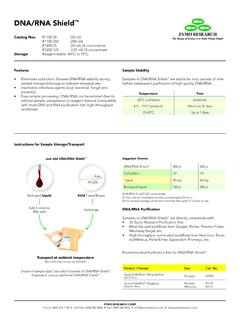Transcription of Biological Nutrient Removal manual
1 Minnesota Pollution Control Agency 520 Lafayette Rd N St. Paul, MN 55155-4194 651-296-6300 Toll free 800-657-3864 August 2011 Biological Nutrient Removal Authors Kay Curtin Steve Duerre Brian Fitzpatrick Pam Meyer Editing and Graphic Design Nancy Ellefson The Minnesota Pollution Control Agency acknowledges with appreciation the Water Environment Federation and the Wisconsin Department of Natural Resources for use of their information on Biological and chemical phosphorus Removal in this manual .
2 Printed on 100% post-consumer recycled content paper manufactured without chlorine or chlorine derivatives. Biological Nutrient Removal | Contents 1 Table of contents Acronyms .. 2 Glossary of Nutrient Removal Terms .. 3-8 Introduction .. 9-13 Nitrogen Removal .. 13-17 Phosphorus Removal .. 18-24 Monitoring and process control analyses .. 25-38 India ink stain for exocellular lipopolysaccharides .. 37 Calculations for Biological nitrogen and phosphosphorus Removal .. 39-42 Optimization and troubleshooting guides.
3 43-61 Guide #1: Loadings .. 44 Guide #2: Aeration/mixing diffused aeration .. 49 Guide #3: Aeration/mixing mechanical .. 51 Guide#4: Biomass inventory .. 53 Guide #5: Clarifier operation .. 55 Guide #6: Internal recycle .. 57 Guide #7: pH/alkalinity .. 58 Guide #8: Toxicity .. 59 Guide #9: Sudden loss of chemical phosphorus Removal .. 60 Guide#10: Gradual loss of chemical phosphorus Removal .. 61 References for Biological Nutrient Removal .. 62 Chemical phosphorus Removal .. 63 MPCA Wastewater Contacts.
4 699 Tables 1-11 Table 1: Phosphorus in domestic wastewater .. 18 Table 2: Optimum dissolved oxygen levels in zones .. 28 Table 3: Desired conditions and millivolt meter readings by zone .. 33 Table 4: Standard methods for the examination of water and wastewater reference methods .. 35 Table 5: Suggested daily process control calculations for optimum BNR .. 36 Table 6: Process control parameters .. 38 Table 7: Possible sources of nutrients and Nutrient Removal problems .. 42 Table 8: Characteristics of frequently used phosphorus Removal chemicals.
5 63 Table 9: Chemical information .. 64 Table 10: Advantages and disadvantages of different addition points .. 66 Table 11: Weight ratios for commonly used metal salts .. 67 2 2010 Minnesota Pollution Control Agency | All rights reserved. Acronyms Nitrogen Phosphorus N Elemental form of nitrogen P Elemental form of phosphorus N Atmospheric nitrogen (nitrogen gas) PO Orthophosphate NO Nitrite TP Total phosphorus NO N Nitrate H3PO4 Phosphoric acid NOx Oxidized forms of nitrogen (nitrate & nitrite)
6 NH Ammonia nitrogen NH Ammonium TKN Total Kjeldahl Nitrogen Other chemicals O Oxygen NaOH Sodium hydroxide H SO Sulfuric acid F Cl Ferric chloride NaOCl Sodium hypochlorite Cl Chlorine Process control Other BNR Biological Nutrient Removal NPDES National Pollution Discharge Elimination System BOD Biochemical oxygen demand CBOD Carbonaceous biochemical oxygen demand COD Chemical oxygen demand DO Dissolved oxygen HRT Hydraulic retention time MLSS Mixed liquor suspended solids MLVSS Mixed liquor volatile suspended solids ORP Oxidation reduction potential PAO Phosphorus accumulating organisms RAS Return activated sludge SBOD Soluble biochemical oxygen demand SRT Solids retention time SVI Sludge volume index TDS Total dissolved solids TS Total solids TSS Total suspended solids VS Volatile solids VSS Volatile suspended solids WAS Waste activated sludge Biological Nutrient Removal | Glossary 3 Glossary of Nutrient Removal
7 Terms Acinetobacter A common heterotrophic bacteria that functions as a phosphorus-accumulating organism (PAO) in Biological phosphorus Removal Aerobic A condition in which free and dissolved oxygen is available in an aqueous environment (Nitrification is an aerobic process) Alkalinity The capacity of water to neutralize acids by the water s content of carbonates, bicarbonates, hydroxide, and other compounds, also known as buffering capacity Ammonia nitrogen Elemental nitrogen present in the form of ammonia (NH3)
8 Ammonification The process in which soluble organic nitrogen is converted to ammonia Anaerobic A condition in which free, dissolved and combined oxygen is unavailable in an aqueous environment Anionic polymer A negatively charged electrolyte used as a coagulant to aid in settling solids in wastewater Anoxic A condition in which oxygen is only available in a combined form, such as nitrate (NO3), nitrite (NO2) or sulfate (SO4) in an aqueous environment Assimilation The process in which nitrogen is taken in by cells to be used for growth and reproduction Autotrophic organisms Organisms that use carbon dioxide, sunlight, or other inorganic substances for cell growth (Nitrifying bacteria are autotrophic) Biological Nutrient Removal (BNR) The Removal of nitrogen and/or phosphorus by the use of proliferation and selection of certain microbiological populations.
9 Also See Enhanced Biological Phosphorus Removal (EBPR) Biochemical oxygen demand (BOD) The measure of the quantity of oxygen used in the biochemical oxidation of organic matter in a specified time period (usually 5 days), at a specified temperature (usually 20 C), and under specified conditions (in the dark) Blowoff Turbulance in aeration tanks caused by damaged diffusers Carbonaceous biochemical oxygen demand (CBOD) A quantitative measure of the amount of dissolved oxygen required for the Biological oxidation of carbon-containing compounds in a sample Chemical oxygen demand (COD) A test used to measure indirectly organic compounds in water or wastewater.
10 (The advantage of COD over BOD analyses is that COD takes only a matter of hours to complete compared to 5 days for a BOD test; the value is usually higher than BOD) Chlorine sponge See Nitrite Lock Denitrification The Biological reduction of nitrate-nitrogen to nitrogen gas in an anoxic environment Dissolved oxygen (DO) Molecular oxygen dissolved in water or wastewater A B C D 4 2010 Minnesota Pollution Control Agency | All rights reserved. Enhanced Biological phosphorus Removal (EBPR) The process of phosphorus Removal in wastewater that relies on the proliferation and selection of a microbiological population capable of storing phosphorus in excess of their normal growth requirements.
